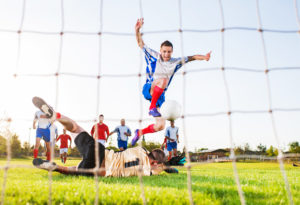
As participation in soccer continues to explode and physicality in the sport increases, we are seeing more and more injuries to the shoulder in young athletes.
Three of the more common upper extremity injuries we see from athletes participating in soccer are: clavicle fractures, AC joint separations and shoulder dislocations.
A relatively common shoulder injury seen in soccer players is a clavicle (“collarbone”) fracture. Symptoms of a clavicle fracture include pain and swelling at the site of injury. Because there is little skin overlying the clavicle, a fracture is usually pretty easy to spot. There can be a deformity or a bump at the middle of the clavicle. This area is usually very tender to touch and movement of the arm becomes painful. Many clavicle fractures can be treated with a short period of sling immobilization, but If a player has a suspected clavicle fracture, it is important to talk with an orthopedic surgeon who routinely treats shoulder injuries so that they can evaluate the extent of the injury and whether surgery may be right for them.
Another relatively common shoulder injury is an acromioclavicular (“AC”) joint separation, also known as a shoulder separation. This often occurs as the result of a fall directly onto the shoulder. Apart from pain in the shoulder region, it can sometimes be more difficult to pick up on an AC joint injury. In very severe cases there can be a deformity where the collarbone appears to be sticking above the rest of the shoulder, but this is rare. Diagnosis of an AC joint injury usually involves an X-ray and exam by an orthopedic physician specializing in shoulder injuries. Fortunately, most injuries to the AC joint can be treated with a brief period of immobilization and rest followed by gradual return to activity. In rare instances surgery is needed.
Lastly, the shoulder can also be at risk for dislocation if a player lands awkwardly on an outstretched hand. This injury could occur in the instance when a goalie dives to make a save and lands with his or her arm outstretched above their head. Typically there will be an obvious deformity of the shoulder and the player will be unable to move their arm. Sometimes a shoulder dislocation will go back in place or “reduce” on its own, but most of the time it requires a medical professional to reduce the shoulder. This is usually best done in the emergency department where x-rays can be obtained afterwards to ensure that the shoulder is appropriately positioned in the joint. After a shoulder dislocation has been reduced it is important that appropriate treatment is provided to prevent recurrent instability from developing in the injured shoulder. This may include physical therapy or in extreme cases surgical intervention to reinforce the stability of the joint.
If you’re having shoulder troubles or think you may have sustained one of these injuries during a game or practice its best to be evaluated by an orthopedic surgeon who specializes in treatment of shoulder or sports injuries.




